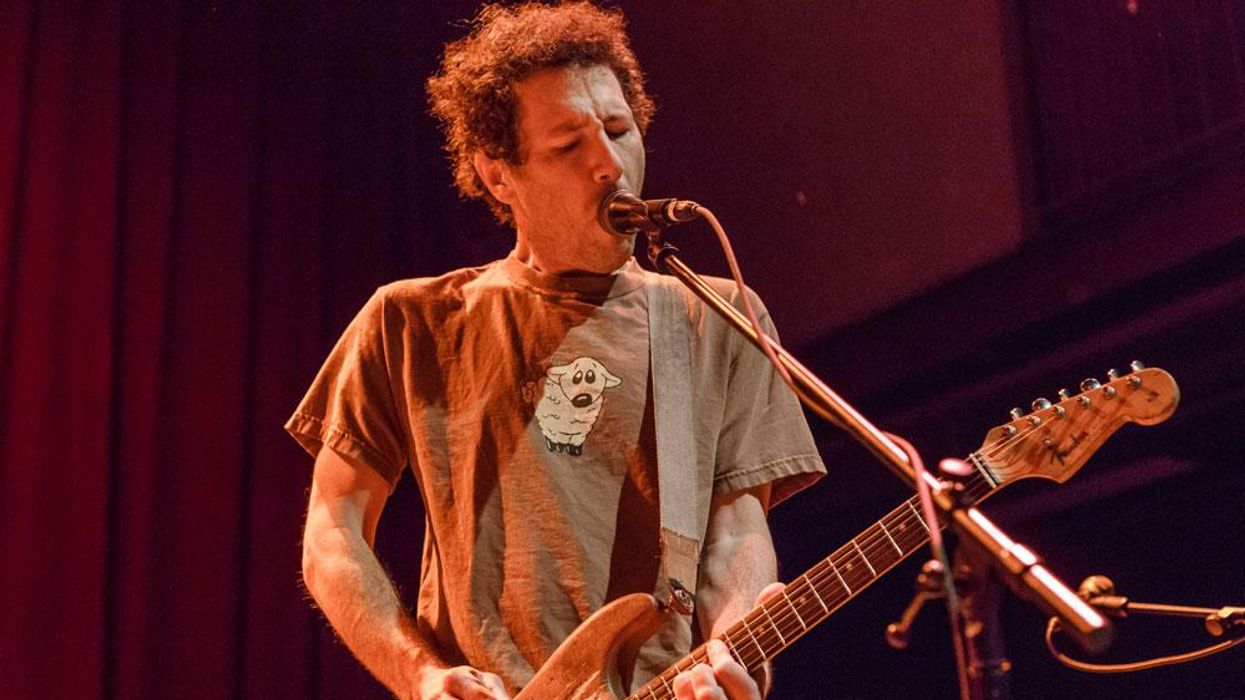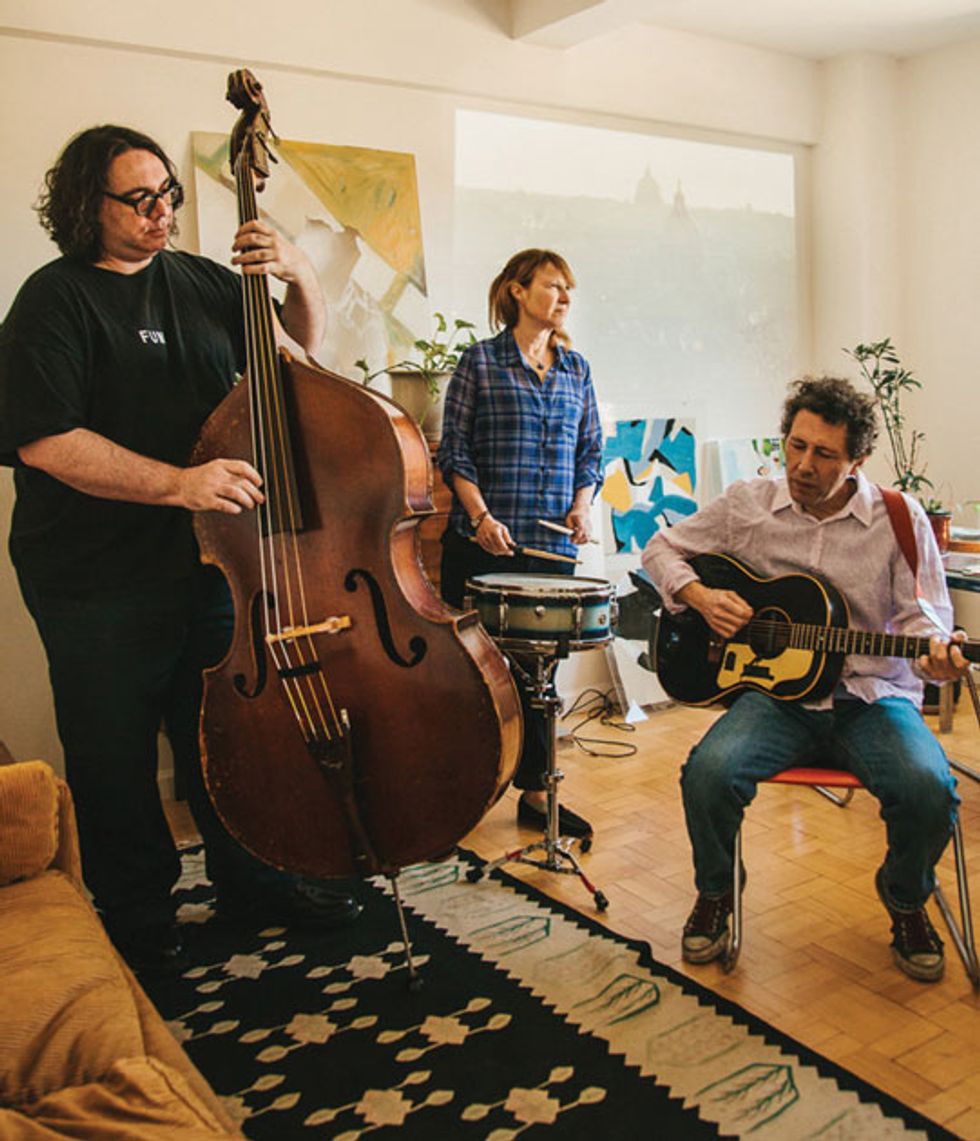For 30 years, Yo La Tengo has been combining fuzz guitar freak-outs and gorgeous vocal harmonies to create sweet, somnolent pop served with an arid sense of humor. While many guitarists who were part of the '90s indie-rock explosion steered clear of lengthy solos, YLT's guitarist and singer Ira Kaplan embraces them. Equally at home throwing out a flurry of notes or bending a single tone into howling feedback and holding it for measures, Kaplan draws equally from downtown NYC minimalists and such Bowery hotshots as Robert Quine.
Though Yo La Tengo has a deep, eclectic catalog of original songs, fans have come to expect a few inspired covers in every live set. Released in 1990, Fakebook contained 11 such favorites, and now—a quarter of a century later—YLT has released Stuff Like That There as its companion.
We spoke with Kaplan about this new album, his first electric guitar and amp (both of which he still uses), what it's like to be content with aging effects, and his other covers project.
When did you first start playing guitar?
I had some folk guitar lessons when I was very young—before I was 10, for sure.My mom played guitar, so I grew up around it, and both my parents were folk music fans. The Weavers loomed very large in our household and community, and I'm sure Hootenanny was an influence on my parents. Both of them wanted their kids to take music lessons of some sort, and when I showed interest in the guitar, they encouraged me to take those lessons.
Did you identify guitar with a particular band you admired?
Like a lot of people my age, seeing the Beatles on The Ed Sullivan Show was a turning point. I started playing my nylon string acoustic with a pick, which beat the crap out of the wood. My mom had a pickguard put on it because I was just sanding it down, inadvertently, with the pick.
When did you get your first electric?
I bought a Stratocaster in the late '60s or very early '70s—it's the one I continue to play today. I wanted an electric guitar, and a neighbor told me about someone he knew who was selling a guitar and amp. Pre-internet, I somehow managed to determine it was a good deal. So I bought this Stratocaster and Vibrolux I use to this day. I don't know the exact year of either, but the Vibrolux is a blackface.
Who were your main electric guitar influences?
Oh god, I was never that person. I never tried to learn songs off records. I'd try to learn the chords off records, but the idea of learning parts—“Oh, I love this Jeff Beck song, I'm going to try to figure out what he's doing"—was so alien to me. I didn't even realize I was supposed to be doing it. I came from a real hippie town, so the long guitar solo was definitely a popular item in my circle of friends. Whether it was the Allman Brothers, the Grateful Dead, or Eric Clapton, I was soaking up all that.
That's surprising—I've always associated Yo La Tengo with a very downtown New York feel, in the vein of late-'70s bands like Television.
In the period I'm talking about, those bands didn't exist yet. The Velvet Underground existed, but I wasn't familiar with them until later. The first record of theirs I heard was 1969: The Velvet Underground Live, but I certainly didn't hear it when it came out. That album definitely caused a huge change in my listening habits.
Stuff Like That There is Yo La Tengo's second covers record, and covers have always been a big part of your live set. How do you pick them?
It just happens. I remember a show we played in Asheville, North Carolina, when there was a biblical rainstorm. I honestly didn't believe anybody was going to come out to that show, but a couple of people did. We thought well, let's make this day topical, so at soundcheck, we worked up three songs about rain. We've also played parties over the years and taken requests.
We draw up a list of songs we feel like doing again and then simply whittle it down. Both Fakebook and Stuff Like That There were similar in that regard. If I remember correctly, none of the covers on Fakebook were new to us when we recorded them, but in the case of Stuff Like That There, there are actually four or five songs we learned specifically for it. Once we'd mentally committed ourselves to making this record and started rehearsing, all sorts of ideas kept coming to us and we kept trying out different things.
You're already releasing covers as Yo La Tengo, so what inspired you to record a covers record under the band name Condo Fucks?
That wasn't planned. When I have time, I play with the A-Bones [a Brooklyn garage-rock band]. They were playing at a bar in Brooklyn we were fond of that was about to close, so we offered ourselves as the A-Bones' opening act. We weren't going to do a Yo La Tengo set, so we wanted to perform under a different name. We came up with the name Condo Fucks and picked 11 songs to cover that night. Then James [McNew, YLT's bass player] had gotten some new microphones or a Pro Tools update, perhaps. Whatever the reason, James suggested we record a rehearsal so he could practice. We ran through the set twice and recorded it. Listening back, we thought, “Wow, that sounds good, we should put this out." Once we came up with the title Fuckbook, we knew we had to release it.
Ira Kaplan with his YLT bandmates, bassist James McNew and drummer Georgia Hubley. “Like a lot of people my age," says Kaplan, “seeing the Beatles on The Ed Sullivan Show was a turning point."
Yo La Tengo predates early-'90s British dream pop and shoegaze bands, but you get lumped in with them a lot. Did you feel any kinship with those bands?
Well, My Bloody Valentine, for sure. We certainly felt a kinship with gazing at our shoes and nothing else. I remember a friend of mine giving us a copy of Loveless, saying we should hear it, thinking we were going to love it as much as we did. We were big fans of that band in particular.
How much of an influence did the more poppy bands of the '70s, like Big Star, change the way you thought about guitar?
Well, my introduction to Big Star was actually through Chris Stamey, of the dB's. I went to see Alex Chilton's solo project at CBGB. A friend suggested going to see him, and identified him as the singer from the '60s band, the Box Tops, who had that song “The Letter." This was before Big Star. It seemed impossible that this was the guy from the Box Tops. It was so different from that, and I loved them.
'I've already got one.'"
Soon after that show, I found out how much of Alex's solo repertoire was from the three Big Star records. Two of them had been released, but Third hadn't been issued yet. At that point, I started tracking down Big Star's music, getting copies of #1 Record and Radio City, and then I snapped up Third when it came out. I don't know if it's just because that was my introduction, but in a lot of ways, I preferred Alex's solo band to Big Star. The anarchy of it all. Third is a perfect record in every way, but the “what's going to happen next?" aspect of the solo shows was really special to me.
Your band is unrestrained and able to improvise fairly easily. How do things fall into place onstage when you decide you're going to take an extended solo or draw a song out a little longer?
It depends on the song. There's usually a look. You can only go so long, but occasionally I come out of those things on the wrong beat. I'll get so tangled up in what I'm doing that James and Georgia have to kind of lurch to turn what I'm doing back into something resembling music.
Ira Kaplan's Gear
Guitars
1960s Fender Stratocaster
1960s Fender Coronado
Amps
1960s Fender Vibrolux
1960s Fender Super Reverb
Effects
Boss Tuner
Vox wah
Pro Co RAT (2)
Boss Turbo Overdrive
Boss Compressor
Boss EQ
Line 6 MM4
Line 6 DL4
DigiTech PDS 8000 Echo Plus
Strings and Picks
Dunlop Tortex .60 mm
.011 sets
You sometimes play a Fender Coronado, which has a reputation as difficult to play and handle. What do you like about it?
That it's difficult to handle [laughs]. It's a feedback machine!
If you had to limit yourself to three pedals, tuner not included, what would they be?
Well, I've used a RAT for so many years. I keep wanting to use something else, something groovier. We have all these boutique fuzz boxes, but I'm so comfortable with the RAT. I can get a variety of sounds with it, and I know how to get them quickly.
Along similar lines, I've used my old DigiTech
Echo Plus for so many years. It's a delay pedal that also has looping. Even though it's so noisy and hard to get repaired, it just feels like the 7th string of the guitar. Then there's a more modern delay with a looper that I like—the green Line 6 DL4. It's just so easy and great to use.
Take us through your signal path.
Two RATs, a Vox wah, a Boss Compressor, a Boss Turbo Overdrive, a Boss EQ, and the DigiTech Echo Plus, mainly.Once I get something, I rarely switch from it. As you're probably discerning, I'm not someone who tries out a lot of new things and then thinks, “Oh, this is doing the same thing, only better!" It's more like, “I've already got one." So things that I've had over the years tend to stay.
I have a switch that routes the wah to one amp or both amps. Everything to the right of the wah is going to both amps, and everything to the left of the wah is going just to one of the amps. That's why there are two RAT pedals. I have the option of playing one amp clean or using both amps.
YouTube It
In this video for “From a Motel 6," from YLT's 1993 album, Painful, indie film director Hal Hartley has the band set up and take down their gear just for the brief freak-out guitar solo.
And what are those two amps?
One is the old Vibrolux I've had forever. It has a 12" speaker in it instead of two 10s. The second amp is usually a Super Reverb. If only one amp is distorted, it'll be the Super.
Your reverb and tremolo come from the amp and not stompboxes?
That's right.
In the video for “From a Motel 6," the whole band sets up its gear, you play a 15-second solo, and then the band immediately tears everything back down. Who thought of that?
That was mainly [film director] Hal Hartley's idea. I had the idea of us setting up and breaking down as part of it, but it was Hal who had the concept of making that the entire video. I figured it was just going to be an element, but it turned out to be the whole thing. I thought that was hilarious.









![Rig Rundown: Russian Circles’ Mike Sullivan [2025]](https://www.premierguitar.com/media-library/youtube.jpg?id=62303631&width=1245&height=700&quality=70&coordinates=0%2C0%2C0%2C0)


























